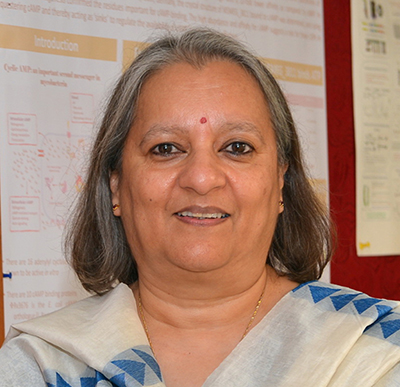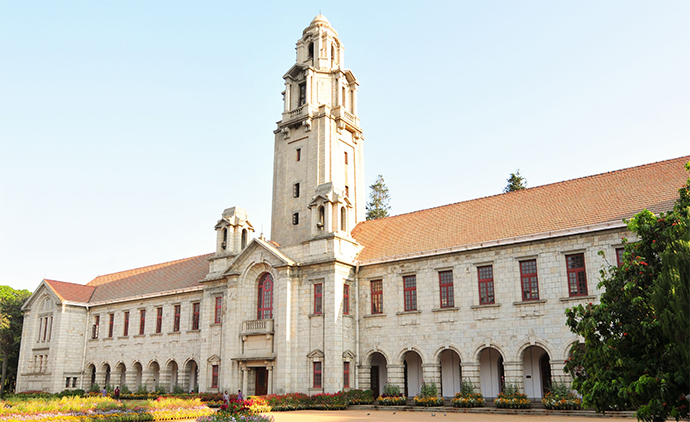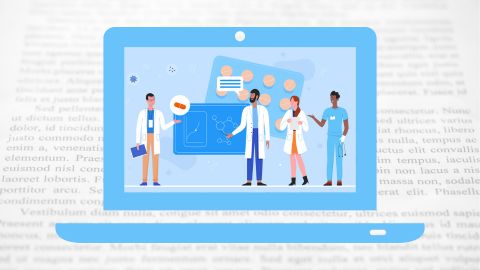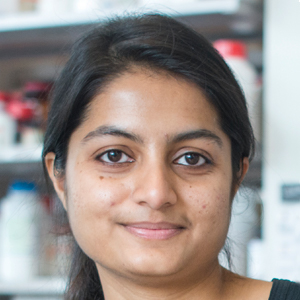Sandhya Visweswariah does a balancing act between science and her society
While the global scientific community still leans toward patriarchy, Sandhya Visweswariah has made a mark for herself as one of the most prominent women in science in India.
 In addition to her study of the implications of cyclic nucleotides in diarrhea, Sandhya Visweswariah works to remove roadblocks for women in science in India.Courtesy of Sandhya Visweswariah
In addition to her study of the implications of cyclic nucleotides in diarrhea, Sandhya Visweswariah works to remove roadblocks for women in science in India.Courtesy of Sandhya Visweswariah
Visweswariah chairs the department of molecular reproduction, development and genetics at the Indian Institute of Science in Bangalore, India, and co-chairs the institute’s Center for BioSystems Science and Engineering, which she helped establish in 2015. She has won international recognition for her work on watery diarrhea and cyclic nucleotides in the form of grants and awards from the likes of the Royal Society and the Bill and Melinda Gates Foundation.
Born in India, Visweswariah did her early schooling in England and then Zambia. At the age of 17, she returned to India and earned a bachelor’s degree in botany, chemistry and zoology from Osmania University followed by a master’s in chemistry from the Indian Institute of Technology, Kanpur. She went on to earn a Ph.D. in biochemistry from the IISc.
Over the years, Visweswariah has explored scientific interests in industry as well as in academia; she worked at AstraZeneca before joining the faculty at the IISc. Her initiatives to improve translational research in India earned her the Margadarshi fellowship from the Wellcome Trust/DBT India Alliance in 2017, which provides biomedical scientists with an opportunity to lead cutting-edge interdisciplinary research programs. She was elected a fellow of the World Academy of Sciences in 2018. In addition to her research work, she constantly strives to remove roadblocks for women in science in India; in one notable step, she worked to modify the rules at the IISc to extend the tenure assessment period for women on the faculty by one year per child.
Visweswariah spoke with ASBMB Today contributor Isha Dey about her research and addressed questions about scientific advancement in India and women’s representation in science. The interview has been edited for length and style. This cartoon by Tejeswani Padma, a former project assistant in Visweswariah’s laboratory, depicts the lab’s research interests.Tejeswani Padma
This cartoon by Tejeswani Padma, a former project assistant in Visweswariah’s laboratory, depicts the lab’s research interests.Tejeswani Padma
Tell us about the research in your lab.
My lab is interested in looking at old-fashioned cyclic nucleotides like cAMP and cGMP and their implications in diarrhea. Being a biochemist by training, what interests me is how protein structure and function are coupled to cellular physiology like cell-to-cell and cell-to-environment communication. So I look at receptor proteins, which transmit signals from other cells or the environment to elicit a response within a cell.
We study guanylyl cyclase C, a receptor expressed in the gut, which has an extremely complex structure with multiple domains, and try to understand how these domains communicate with each other. We, along with clinicians in Europe, were the first to report that mutations in this receptor cause congenital secretory diarrhea. We have received funding from the Bill and Melinda Gates Foundation to make relevant mouse models to better study this disease.
One of my former students some years ago wanted to look at cAMP in microbes, so we picked up Mycobacterium tuberculosis as a model system. We soon realized that there was little information on the enzymes that regulate cAMP levels in Mycobacteria. So that project has also been a major focus in my lab for the past decade.
How did you become interested in science?
My first interest during my schooling in England was the arts. I was interested in Western music, literature and languages. I was learning German, French, Russian and Latin. However, when I moved to Zambia with my parents at the age of 16, the only subject options given to me in school were physics, chemistry, biology and mathematics.
When I came back to India for college, I continued with my scientific pursuits. Looking back, I feel things worked out the way they should, because I realize that I am more of a scientist than an artist.
Who would you consider to be your mentor/influencer?
Growing up, I won’t say I had a vision of one day becoming a scientist. However, if there is any one person who inspired me to do science, it was Srinivasan Chandrasekaran, an organic chemistry professor at the Indian Institute of Technology, Kanpur, where I did my master’s.
During this time, I realized what it was to do real research. Before that, I never felt that there was any magic in scientific discovery; it was more like memorizing what is written in the textbook. But his approach to science and the way he ran his laboratory inspired me and continue to influence me even now.
Being a graduate student and now a professor at the IISc, how do you think funding and opportunities for translational research in India have changed over the years?
A lot. Resources and funding at my time as a Ph.D. student were in no way comparable to international standards. We had to think of research ideas that were smart but not resource intensive. Funding and interdisciplinary research have dramatically increased in the last decade because of initiatives from the government of India as well as international research collaborations between governments like India and France or India and the U.K.
The biggest game changer has been the Wellcome Trust/DBT funding supporting basic and translational research. Through this initiative, we have set up a collaboration with Christian Medical College in Vellore for an M.D.–Ph.D. program and closer interactions with faculty in IISc. This is to encourage M.D. students in India to become clinician-researchers, which are rare in this country.
What are your thoughts on gender bias against women in science?
What we call bias against women need not be correlated to any kind of harassment; neither is there any conscious prejudice against women by men in science. It is just that men are not sensitized to understand the needs of women during decision making, because they may not be aware that women may have a different view on things. Given my current position in the institute, I have become acutely conscious of this in the last five or six years. For example, ensuring that the tenure process is sensitive to motherhood and that instances of sexual harassment are dealt with sensitively and promptly. That’s when I realized that unless you have women in decision-making positions in leading institutions, you cannot bring in change for the next generation of women.
Because India is a patriarchal society, men are brought up without sensitization toward women’s needs. It is not that they want to exclude women, but there is no positive desire to include them. In the West, over the past decade or so, men have become aware that there are things that women can bring to the table and have made very conscious efforts to include women at all levels in decision making. Unfortunately, in India, we have a long way to go before we reach that level of inclusion.
Fewer than 14% of researchers in India and fewer than 30% of researchers worldwide are women. What can be done to increase women’s representation in science?
 Students at the Indian Institute of Science explain basic science to younger school children during an IISc Open Day.Courtesy of Sandhya VisweswariahAll of this comes from a perceived bias as to what a woman can and can’t do. Women are told from an early age that they are not good in science and engineering. So this is an upbringing problem coupled with the fact that there aren’t enough women in every sphere of activity. Consider teaching, for example; men in general do not consider teaching in elementary school as a good profession, because they are hardly ever taught by men at that stage. Girls in this country might aspire to become movie stars just because they see successful female movie stars. Women should be allowed to choose their career paths and see more varied role models so that we have more women represented in every sphere of activity, not just science.
Students at the Indian Institute of Science explain basic science to younger school children during an IISc Open Day.Courtesy of Sandhya VisweswariahAll of this comes from a perceived bias as to what a woman can and can’t do. Women are told from an early age that they are not good in science and engineering. So this is an upbringing problem coupled with the fact that there aren’t enough women in every sphere of activity. Consider teaching, for example; men in general do not consider teaching in elementary school as a good profession, because they are hardly ever taught by men at that stage. Girls in this country might aspire to become movie stars just because they see successful female movie stars. Women should be allowed to choose their career paths and see more varied role models so that we have more women represented in every sphere of activity, not just science.
Talk about your work as a fellow of the World Academy of Sciences in advancing science in developing countries.
We go to local schools and colleges all over the country and communicate our research and scientific thoughts and ideas to the students in a language that they can comprehend. Last year, I attended the first induction meeting of the World Academy of Sciences, and I was absolutely inspired by young scientists from countries where there is so much turmoil, like Sudan, Iraq, Iran, Syria, Zimbabwe and Palestine, coming and talking about science. I realized how lucky we are to be in India.
How can we tackle prejudices against scientific development, such as religious superstitions and avoiding vaccination?
We need to educate people about basic science and scientific advancement. In parts of India, people marry members of their own families, which sometimes results in transmission of genetic diseases. But they consider the illness a curse of God or fate without being aware of the dominant and recessive gene pool. Visiting a temple and worshiping a deity cannot cure a disease. Unless science is a part of human life, it is difficult to tackle this. This education has to happen in school and also at home in our microenvironment. There has to be better scientific communication across all spheres. We all have the tools — almost everyone has a smartphone — but we do not use them to educate ourselves on issues like this.
What advice would you give to current and prospective women scientists?
Growing up, women are cautioned at different steps about what they can do in a world run by men, and this affects our thought process. We are constantly questioning ourselves: Can I have a family and do science? Can I have a child and still succeed? Can I disagree with my mother-in-law and come in to work?
I was fortunate in being brought up by parents who never made a distinction between my brother and me and never told me there were things I could not do. Therefore, any questions I had along these lines were those that I myself raised after having a child, but I had the confidence given to me by my parents, especially my mother, that I could do it all. The minute we doubt ourselves, we are ready to give up. So women just have to believe that they can do as well if not better than their male colleagues.
What does it take to be a good scientist?
Honestly, I think to be a good scientist, you need to be a decent human being. You have to show empathy. You need broad-mindedness and a liberal way of looking at things — you should be ready to accept that your hypothesis may not be correct. You need to be curious about the world around you and why things are the way they are. We need to have an inherent interest in the field of science coupled with good communication skills to put our ideas across to everyone. Sandhya Visweswariah earned her Ph.D. at the Indian Institute of Science in Bangalore, India, (right) where she now chairs the department of molecular reproduction, development and genetics.IISc Alumni
Sandhya Visweswariah earned her Ph.D. at the Indian Institute of Science in Bangalore, India, (right) where she now chairs the department of molecular reproduction, development and genetics.IISc Alumni
Enjoy reading ASBMB Today?
Become a member to receive the print edition monthly and the digital edition weekly.
Learn moreGet the latest from ASBMB Today
Enter your email address, and we’ll send you a weekly email with recent articles, interviews and more.
Latest in People
People highlights or most popular articles

2024 voter guide
Learn about the candidates running for ASBMB Council, Nominating Committee, Publications Committee and treasurer.

Charles O. Rock (1949 – 2023)
Colleagues and trainees remember a world expert in membrane lipid homeostasis.

Honors for Clemons, Hatzios and Wiemer
Awards, honors, milestones and more. Find out what's happening in the lives of ASBMB members.

Touching the future from the bench
Scholar, scientist, teacher and mentor Odutayo Odunuga discusses the important roles of the institutional PI, his journey and his research.

In memoriam: Darwin Prockop
He held leadership positions at multiple institutions and was known for his contributions to adult stem cell biology and cellular biology.

A look into medical writing
Our careers columnist spoke with Ashlea A. Morgan at Chameleon Communications International to get a sense of one type of work a medical writer can do.

